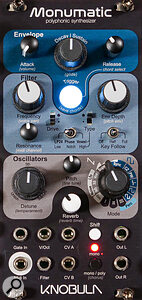The Monumatic is Knobula’s third polyphonic sound generator. It picks up the form and much of the intention of their first outing, the Poly Cinematic, but then expands it and packs in more features while somehow making it feel more intuitive to handle. There’s a certain density to the interface that makes it seem busy, but with the quick‑start guide to hand, you’ll find that Knobula have struck a solid balance between function and usability.
At it’s heart the Monumatic is an eight‑voice polyphonic synthesizer that straps 16 oscillator modes, or engines, on to a single indented knob. These include sync’ed dual‑oscillator waveforms, Casio‑inspired CZ phase distortion, various pulse waves, percussive organs, a Solina‑style ensemble, tape‑wobbling saws, a take on a modulated Oberheim X8, the Vox Humana preset from the Polymoog, and two gooey supersaws. They are all modelled on analogue circuits and sound superb. The choices all follow a similar theme of juicy and mellow sounds, which gives it a nice, consistent vibe. There’s no sudden lurch into FM or wavetables that we can often find on multi‑engine oscillators.
Each mode uses the Detune knob in a slightly different way. On some, it pushes the tuning apart; on others, it’s PWM, or modulation rate, while generally offering a transition from unison to a fifth to a sub‑octave shift. The Mode knob has a pointy bit sticking out to help you know where you are, except it then partially obscures the tiny label that tells you what it is. The best approach is probably to select sounds by ear.
The filter section offers six different types, ranging from two slopes of low‑pass to high‑pass, dual‑notch, phase‑shifter and vocal filter. It has an overdrive that can get quite gnarly at high resonances. It will self‑oscillate, but not in a particularly pleasant way. However, if you back off just a touch, there’s some lovely attitude in there. The filter also gets a dedicated Envelope Depth control, which shares the single envelope with the VCA, and some key‑following options. Hidden under this knob is a strangely velocity‑sensitive pitch envelope.
The presence of CV and MIDI inputs might seem counterintuitive, but Knobula market it as a monophonic CV‑driven synth voice or a polyphonic MIDI synthesizer, which is the perfect way to approach it. As a monophonic modular voice, it has a great range of big, stacked sounds with a lot of energy. As an eight‑voice MIDI synth with MPE support, it can flow from stabby chords into really quite magical soundscapes. I do wonder how many modular customers will miss out on its ability to be a beautiful keyboard‑focused polysynth.
The Monumatic will remember the last chord you played over MIDI and then let you trigger that chord via CV/gate.
However, this can be helped with Chord Mode. This was an innovation from the Poly Cinematic that was a bit awkward to use, but here it feels much improved. The Monumatic will remember the last chord you played over MIDI and then let you trigger that chord via CV/gate. You can store up to eight chords and select them by holding Trigger and turning the Release knob or via a MIDI mod wheel or CV. It provides modular players with a useful polyphonic option.
There is a dedicated CV input for the filter cutoff and then two more CV inputs that can be mapped to any knob you turn within two seconds of plugging in the cable. This includes the Mode knob, which is a lot of fun when you’re sequencing in different sounds for each note.
The Monumatic doesn’t offer a deep level of synthesis fiddling. There’s no waveform mixing, cross‑modulation or FM shenanigans. However, it’s instant, sounds terrific and is a lot of fun to play with. The 16 modes are all killer, with no filler, and you have front‑panel control over exactly what matters. More versatility in a wider range of oscillator engines might be nice, but Knobula have sacrificed that for a collection of superbly crowd‑pleasing sounds that gel together in a fabulous, CV‑selectable, analogue synth‑style vibe. It’s one of the most enjoyable‑sounding synths I’ve played with in ages, maybe because it tickles all the things I love about analogue synths. I imagine that’s the point.

